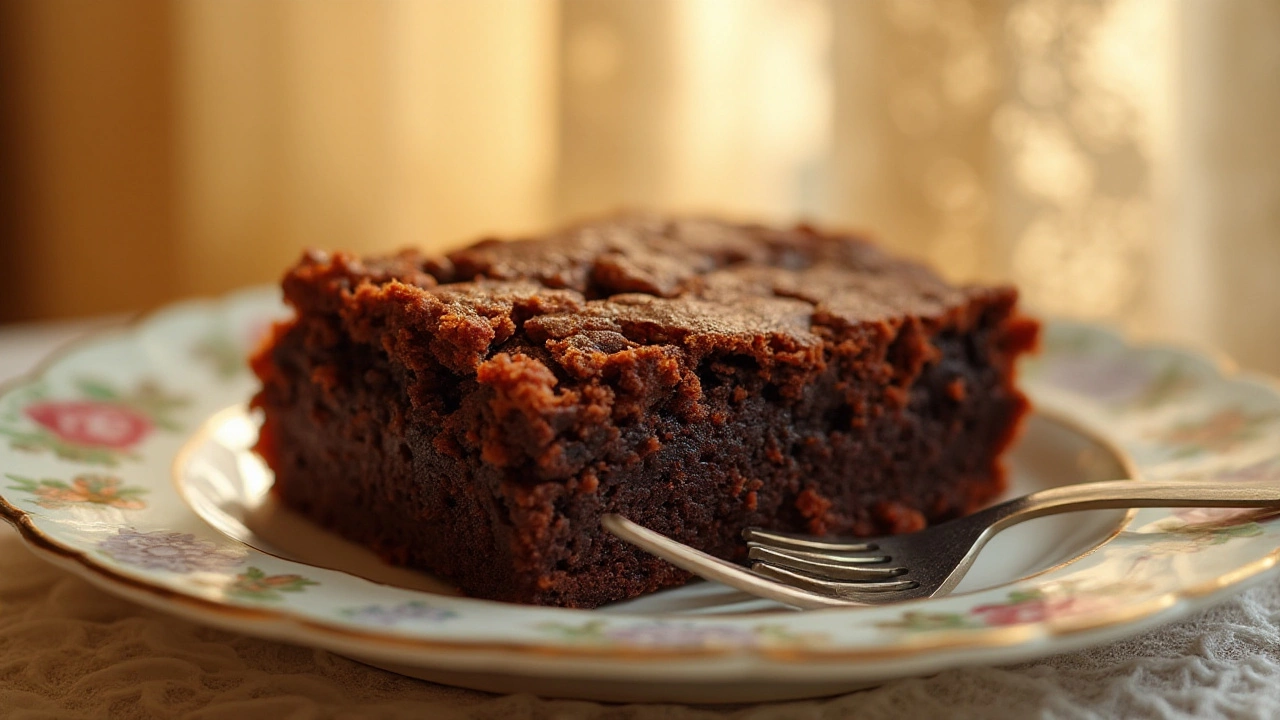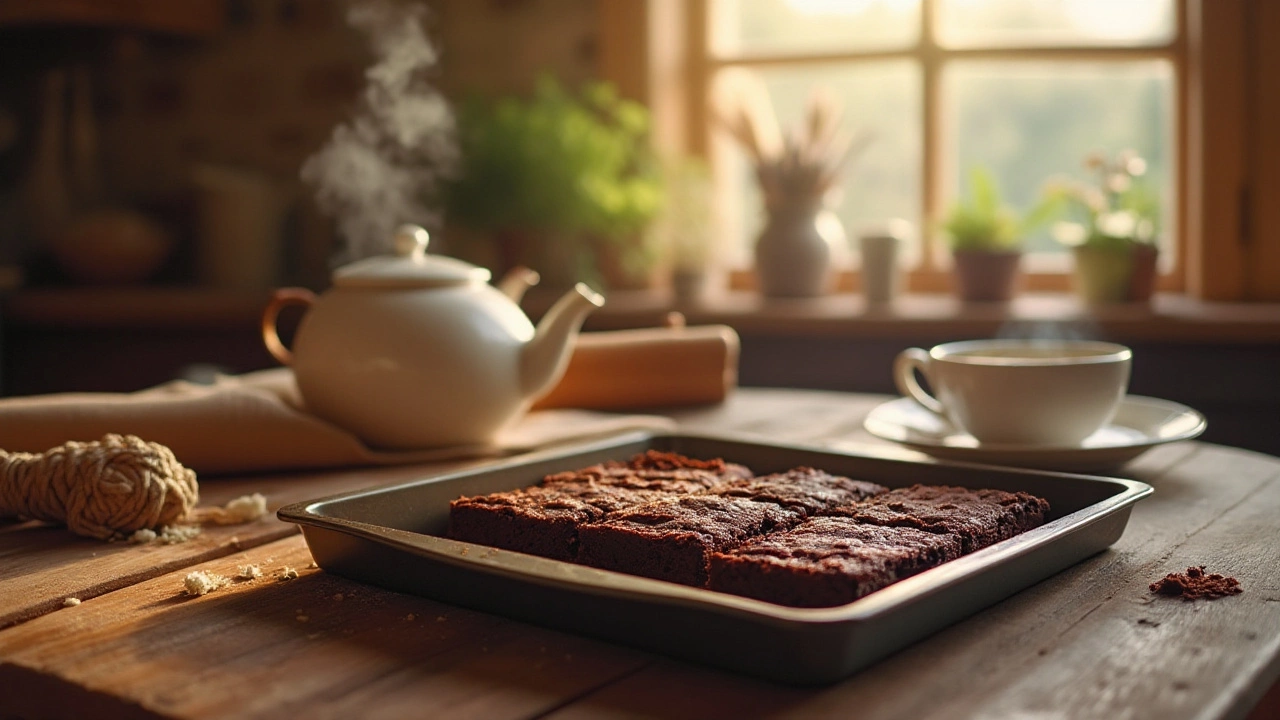Brownies have embarked on a culinary journey that cements them as a staple in desserts. These chocolate wonders captivate the senses with their distinct flavor profile and texture. The magic lies not only in their indulgent chocolate presence but also in the method and ingredients that shape their identity.
Exploring what lies behind the humble brownie reveals a narrative rich in history and experimentation. As enthusiasts of this sweet confection know, every batch tells its story through the careful balance of ingredients and techniques that bring it to life. Discover the secrets behind creating the ultimate brownie and unlock a world of flavors right in your kitchen.
- The Origin of Brownie Flavor
- Key Ingredients and Their Impact
- Balancing Sweetness and Bitterness
- Traditional vs. Modern Brownie Variations
- Tips for Perfecting Texture
- Secrets to Customizing Your Brownie
The Origin of Brownie Flavor
The enticing world of brownie flavor has a rich history that traces back over a century, merging culinary evolution with cultural fascination. The story begins in the late 19th century in the United States, where this delightful treat made its first appearance. Legend has it that the creation of the brownie was a happy accident. One version suggests a cook at the Palmer House Hotel in Chicago mistakenly left out baking powder in a chocolate cake, resulting in a dense yet delightful concoction. Another tale credits a resourceful housewife in Bangor, Maine, who cleverly improvised when she ran out of flour.
These birth stories reflect the creative ingenuity in kitchens of the past, where limitations frequently birthed culinary innovation. Despite their debated origin, brownies gained rapid popularity in America during the early 20th century, especially as a lunchbox staple and an easy-to-make dessert for gatherings. Around that time, chocolate itself was becoming more accessible and affordable, which fueled brownie experimentation. The humble brownie we know and love became an emblem of that era's burgeoning baking enthusiasm. In 'The Boston Cooking-School Cook Book' by Fannie Farmer, a slightly varied version of the brownie recipe first appeared in print, further solidifying its place in culinary history.
The essence of brownie flavor lies in the deep, satisfying combination of cocoa and sugar, intertwined with butter's velvetiness. The contrast between the slightly crisp exterior and the soft, chewy interior makes this dessert a beloved choice. Over time, adaptations have emerged, such as adding nuts or experimenting with flavored chocolates, each offering a unique twist on tradition. An interesting statistic from recent culinary studies shows that 30% of homemade brownies incorporate some form of nuts, highlighting the dessert's versatility. Brownie's enduring charm is also connected to its capacity for customization, inviting both amateur bakers and professionals to innovate with textures and ingredients.
An iconic comment on this dessert comes from culinary historian Shirley Corriher, who wrote, "Brownies symbolize the perfect intersection of chocolate intensity and buttery sweetness, a testament to their enduring appeal." This notion captures the universal allure of brownie flavor, which rests in its balance of sweet satisfaction and chocolate richness. As palates evolved, so did the interpretations of brownies. Today, while the core components remain, modern variants embrace everything from salted caramel swirls to sophisticated ganaches, reflecting the dessert's endless adaptability.
Key Ingredients and Their Impact
The elements that create the iconic brownie flavor extend beyond the conventional pairing of chocolate and butter. Each ingredient plays a pivotal role, orchestrating a balance between taste and texture. Chocolate, undoubtedly the star, can vary from bittersweet to semisweet, affecting not just flavor but the richness of the treat. High-quality chocolate is essential to achieve a profound taste, often sourced from recognized origins that ensure depth and intensity.
Butter, another cornerstone, contributes to the dense texture that distinguishes brownies from other chocolate desserts. Its creamy fat content melds seamlessly with sugar and chocolate, adding a tender crumb that's slightly crispy on the edges. A pinch of salt may seem humble, but it is indispensable in accentuating the sweetness and enhancing the chocolate's essence. It brings out the natural flavors, preventing the dessert from becoming cloyingly sweet.
Then there is sugar, the sweet anchor that marries all ingredients. Brown sugar, with its molasses undertones, sometimes replaces or complements white sugar, infusing the brownie with a caramel-like depth. Eggs, often understated, serve as the binding agent, giving structure and contributing to the creamy interior that defines a perfect brownie. They wield the power to influence the density and leavening slightly, depending on how they are incorporated.
Flour might be misleadingly simple, yet its choice of type and quantity can transform the outcome significantly. All-purpose flour is commonly used, but for those seeking a more decadent chew, a blend with cake flour might be the path to take. For gluten-free adaptations, almond or coconut flour can also weave similar magic without sacrificing flavor.
"The best recipes for brownies focus on the quality of ingredients," notes a renowned pastry chef, "not how fancy the additions are."
Baking powder or baking soda is rarely a participant in recipes aspiring for fudginess; however, a touch of leavening can uplift the batter to result in a cakier consistency, providing a delightful contrast for those preferring a lighter bite.
Ultimately, the beauty of brownies is in their adaptability and how these core ingredients interact to develop the ultimate chocolate dessert. Whether meticulously measuring out ingredients or experimenting with various additions like nuts or spices, understanding these fundamental components allows bakers to customize their creation, satisfying a variety of palates.

Balancing Sweetness and Bitterness
The chocolate brownie is more than just a sweet treat; it is a culinary masterpiece that requires precision in handling its flavors. The beauty of brownies lies in their ability to balance sweetness and bitterness, creating a harmonious taste that resonates with chocolate lovers worldwide. This balance is crucial because too much sugar can make the dessert overly sweet, while excessive cocoa can render it too bitter. As with many recipes, the magic begins with the choice of ingredients. High-quality cocoa or dark chocolate serves as the backbone of the flavor profile and plays a significant role in determining the degree of bitterness in the brownies. To counterbalance this, the right amount of sugar must be introduced, ensuring that neither component overwhelms the other.
Lovers of these chocolate delights often talk about the satisfaction of a perfect blend. Achieving this involves understanding each ingredient's impact on taste. When sugar and cocoa are combined, they create a beautiful fusion of sweet and bitter tones, giving the brownie flavor its signature depth. Sugar serves as a vehicle that carries and enhances chocolate’s natural bitterness, turning it into something intensely flavorful rather than acrid. It is fascinating to learn that some iconic recipes suggest using brown sugar instead of white, as it provides a richer molasses-like undertone that complements the chocolatey bitterness beautifully.
The process of crafting this balance can vary depending on preferred taste. Recipes often call for specific ratios, typically one part cocoa to two parts sugar, but it can differ based on personal preference or the type of brownie being created. Some bakers believe that the incorporation of vanilla or a pinch of salt can further neutralize the bitterness, highlighting the chocolate's vibrant essence. "In the art of cooking, sugar has the capability to soften the sharp edges of cocoa," noted renowned pastry chef Michel Roux. Experimenting with ratios and types of sugars—such as demerara or even honey—can yield interesting variations on the classic brownie taste.
Expert bakers also delve into other elements such as the butter used, which can equally impact sweetness perception. Fresh, unsalted butter often allows the natural flavors of chocolate and sugar to shine without external interference. Meanwhile, adding a splash of coffee or brewed espresso is a trick some bakers use to enhance the chocolate flavor; coffee’s natural bitterness subtly rounds out sweet flavors without overpowering them. Achieving the right sweetness and bitterness in brownies is indeed an art, inviting bakers to explore ingredients and techniques that harmonize to create perfection. For those eager to try different flavor profiles, keeping a taste log can be beneficial. This way, they learn which combinations of ingredients heighten the satisfaction of every bite.
Traditional vs. Modern Brownie Variations
The brownie, in its original form, is a timeless classic that has been delighting dessert lovers for decades. Traditionally, a brownie was characterized by its cocoa-rich flavor, fudgy texture, and a simple list of ingredients: butter, sugar, eggs, and flour. Some recipes would call for the addition of nuts, such as walnuts or pecans, which added a satisfying crunch and a slightly savory depth to this sweet treat. The key to the classic brownie was its texture—the perfect balance between a slightly crispy crust and a gooey, moist center, a result of the right baking time and quality ingredients.
With the evolution of culinary arts, modern variations of brownies emerged, each bringing its own twist to the traditional formula. Today's brownies can be found infused with exotic flavors and ingredients such as matcha, salted caramel, and even chili pepper for those with an adventurous palate. The inclusion of alternative flours, like almond or coconut flour, allows for gluten-free options without sacrificing the beloved texture. Vegan brownies, replacing eggs and butter with substitutes like applesauce or avocado, cater to dietary preferences while promising rich chocolatey decadence.
"A brownie should tell a story of flavor, texture, and innovation yet respect its origins," remarks well-known pastry chef Claire Saffitz.
The journey from a traditional to a modern brownie is a testament to the dessert's versatility and the boundless creativity of bakers. With technology and the sharing of global recipes, bakers employ unique techniques, such as using browned butter for a nutty undertone or incorporating espresso powder to enhance the chocolate's depth. Yet, at the heart of all these variations remains the essential charm of the brownie—a dessert that is both comfortingly familiar and endlessly adaptable. This fusion of tradition and innovation not only keeps the brownie relevant but also allows it to continually surprise and delight those who indulge in it. Whether you prefer a classic fudgy core or a contemporary twist, the brownie invites exploration, ensuring it remains a cherished favorite across generations.

Tips for Perfecting Texture
Perfecting the texture of your brownies is an art and science that often marks the difference between a good brownie and a truly great one. The texture involves a slightly crisp top layer paired with a fudgy or cakey interior, which largely depends on the ingredient proportions and baking process. The type of fat, sugar, eggs, and flour used distinctively affects the outcome. For instance, using melted butter will yield a denser, fudgier brownie, while incorporating creamed butter introduces air into the mix, leaning towards a cake-like consistency.
The amount of sugar is crucial to attaining the desired level of moisture. A higher sugar content can help develop the brownie flavor along with a delectable shiny crust. Eggs also play a pivotal role; more eggs provide structure while fewer lead to a chewier texture. A tip for achieving a richer, decadent flavor is using brown sugar, which contributes a touch of molasses earthy sweetness compared to granulated sugar.
"Brownies, with their captivating diversity in flavor and texture, whisper tales of comfort and decadence." - Dessert Literature Journal
Balancing the dry ingredients is paramount. Opting for all-purpose flour assists in providing structure, yet too much can dry out your brownie. For an indulgent mouthfeel, try substituting a part of it with cocoa powder, amplifying the chocolate punch. To ensure the perfect bake, an aluminum baking pan is recommended, distributing heat evenly, while non-stick or glass pans might alter baking time and results.
Adjusting Baking Time
How long you bake your brownies is fundamental to influencing their texture. Baking for too long will dry them out, while pulling them out too soon could leave them overly gooey. An appropriate range for baking time is usually 20 to 30 minutes, but checking with a toothpick can help. The ideal brownie should have moist crumbs adhering to the tester instead of liquid batter. Remember that brownies continue to cook slightly as they cool, which is another reason to avoid going past the optimal baking stage.
Cooling and Cutting
Patience is a virtue when it comes to cooling your brownie. Allowing it to rest gives the flavors a chance to mature and ensures easier cutting. Using a plastic knife can prevent tearing and promote clean cuts, maintaining the brownie structure intact. If you’re feeling adventurous, consider inserting these delicious squares in new recipes or serving ideas; pair with a scoop of ice cream, create brownie trifles, or simply enjoy the art of savoring them on their own.
Secrets to Customizing Your Brownie
Your journey to the perfect brownie involves more than just a basic recipe. It's about weaving your personal touch into this chocolate masterpiece, creating something uniquely yours. Consider the brownie flavor as a blank canvas, eagerly waiting for your creative input. Start by reimagining the proportions of sugar, chocolate, and butter to tweak the dessert's sweetness and richness. Dark chocolate can offer a bolder, more intense flavor profile, whereas milk chocolate lends a creamier and milder taste. The choice of chocolate profoundly impacts the final product, so experiment with different cocoa percentages until you find the balance that pleases your palate.
Another exciting way to add character is through mix-ins and toppings. Nuts provide a delightful crunch, and choosing between pecans, walnuts or even macadamias can alter the texture significantly. For those who crave a fruity bite, consider swirling in raspberry or strawberry jam before baking. This can create a surprising juxtaposition of flavors that cuts through the richness. If you're feeling adventurous, coconut flakes or crushed peppermint can offer seasonal flair. Adjusting your dessert recipes to accommodate these additions can make your brownies stand out during any occasion.
Spices can be a surprising yet effective way to elevate the brownie experience. A dash of cinnamon or a hint of chili powder can turn your chocolate squares into a gourmet treat that keeps people guessing. The idea is to add just enough to enhance, not overpower. Similarly, incorporating extracts like vanilla or almond can subtly shift the flavor. Even the most minute adjustments can ripple out into big changes in taste and aroma. As culinary expert Alice Medrich once said:
"Experimenting with flavors is how we keep building on traditional desserts to create something new and exciting."
If texture is your concern, there's room to play there as well. Achieving a fudgy or cakey consistency hinges largely on your egg-to-flour ratio. More eggs contribute to a denser, fudge-like quality, while a little more flour can lead to a cake-like finish. Understanding this delicate balance is key, and it might take a few batches of trial and error to get right. Remember, the ultimate brownie texture is a personal decision matching your individual taste preference.
For a balance of sweet and savory, consider incorporating sea salt. This addition not only enhances the chocolate but also imparts a complex depth that’s unexpectedly delightful. Simply sprinkle a touch of flaky sea salt over the batter before baking. A little goes a long way, creating a sophisticated taste that elevates the traditional chocolate dessert.
Finally, when looking to elevate the presentation, think about the tools you use. Using a silicone mold instead of a standard baking tray can create picture-perfect squares or playful shapes. These little changes can make your brownies more than just a treat—they become a crafted experience. Whether you’re baking for a special occasion or simply indulging after dinner, customizing is about making your brownies not just delicious, but memorable.





